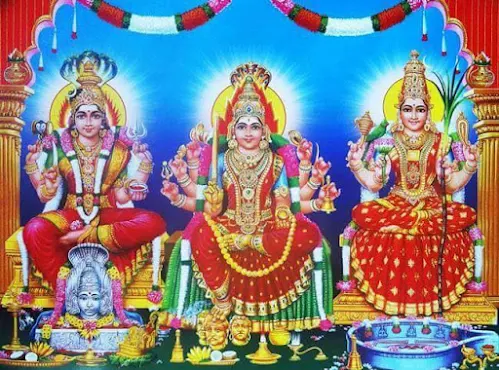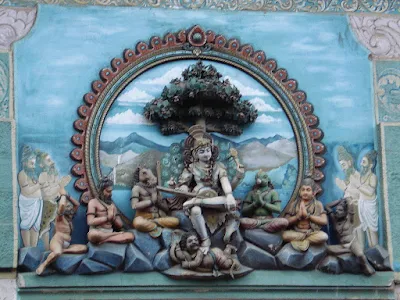The sacred Tamil solar month of - ஆடி / आषाढ (āḍi / āṣāḍha) begins today. This month corresponds to Gregorian calendar between July mid to August mid. Astrologically (and thereby astronomically) speaking, the beginning of ஆடி (āḍi) corresponds to the celestial event of कर्क सङ्क्रान्ति (karka saṅkrānti - Cancer transition) that is, the annual transition of the सूर्य (sūrya - sun) to the कर्कटक राशि / கடக ராசி (karkaṭaka rāśi / kaṭaka rāsi - Cancer Zodiac) from here on begins दक्षिणायण सूर्यस्य (dakṣiṇāyaṇa sūryasya - southward movement of sun) - theologized as भगवान् श्री सूर्य नरायण (bhagavān śrī sūrya narāyaṇa). In terms of (astronomical) seasonal changes, the period of दक्षिणायण पर्वणः (dakṣiṇāyaṇa parvaṇaḥ - period of southward movement) falls between the two celestial events of the ग्रीष्म अयन (grīṣma ayana - summer solstice) and the हेमन्त अयन (hemanta ayana - winter solstice). Etymologically speaking, the English term ‘solstice’ is derived from the Latin words’ ‘sol’, meaning ‘Sun’ and ‘sister’ that means ‘to stand still’.
Please remember that, in this context, such traditional calculation of दक्षिणायण (dakṣiṇāyaṇa - southward movement) is based on the Tamil Solar calendar beginning from Tamil solar month தை (thai), corresponding to मकर सङ्क्रान्ति (makara saṅkrānti – transition to capricorn) celebrated as சூரிய பொங்கள் (sūrya pongaḷ), when the सूर्य (sūrya - sun) enters the मकर राशि (makara rāśi – capricorn zodiac). So based on this calendar system, the month of ஆடி / आषाढ (āḍi / āṣāḍha) corresponds to the sixth month, and from here on starts the दक्षिणायण (dakṣiṇāyaṇa - southward movement). Please recollect our geography lessons that Tropic of Cancer & Tropic of Capricorn are significant space-time points in the celestial sphere. The अयनानि (ayanāni - solstices) are again two other points on the ecliptic plane intersecting the circumference of the celestial sphere called उदगयन / उतररायन (udagayana / utararāyana – northern declination / Summer Solstice) in June when the सूर्य (sūrya - sun) is over the Tropic of Cancer, where the tilt of भुवन (bhuvana - earth)s access is closest to the सूर्य (sūrya - sun) and दक्षिणायन (dakṣiṇāyana - the southern declination / Winter Solstice) when the tilt is farthest from the सूर्य (sūrya - sun), which would be above the Tropic of Capricorn sometime in December. Etymologically speaking, the English term ‘solstice’ is derived from the Latin words’ ‘sol’ meaning ‘sun’ and ‘sister’ that means ‘to stand still’. Again, in terms of तारक ऋतुकालः (tāraka ṛtukālaḥ - sidereal seasons) this event marks the beginning of the annual ÀÉ¢ ¸¡Äõ / शिसिर काल (pani kaalam/ śisira kāla – winter time).
Spiritually speaking, as many of us know, the entire month of ஆடி (āḍi) is considered spiritually very vibrant month, as it is loaded with many spiritually significant events including
· ஆடி செவ்வாய் (āḍi sevvāi),
· ஆடி வெள்ளி (āḍi veḷḷi),
· ஆடி கிர்திகை (āḍi kirthigai),
· ஆடி எகாதசி (āḍi ekādasi),
· ஆடி அமாவசை (āḍi amāvāsai),
· ஆடி பூரம் (āḍi pūram),
· ஆடி (பதினெட்டாம்) பெருக்கு (āḍi patiṇeṭṭām perukku)
· வரலக்ஷ்மி விரதம் (varalakṣmi viradham) etc.
This month is also considered as शक्ति पीठ मास / சக்தி பீட மாதம் (śakti pīṭha māsa / sakthi pīda mādham – pedestal month of spiritual energy). However, unfortunately, among many ignorant masses, this sacred term "பீட மாதம் (pīda mādham – pedestal month)" has been badly corrupted and is used in a derogatory sense of "பீபீடை மாசம் (pīdai māsam – inauspicious/evil month)" as they superstitiously believe that the scriptures advise not to plan any marriages or any other auspicious domestic events during this month. However, the truth is otherwise. Yes, although it is true that it is generally recommended not to avoid such events, as far as possible; yet the reason for that is not because the month is considered பீடை மாசம் (pīdai māsam – inauspicious/evil month). On the other hand, this month is considered too sacred or spiritual to indulge in mere लौकिक /भौतीक कार्यक्रमाः (laukika/ bhautīka kāryakramā - mundane materialistic activities) rather than focusing on अध्यत्मिक / अथिदैवीक कार्यक्रमाः (adhyatmika /athidaivīka kāryakramāḥ - spiritual / divine activities).
Interestingly the Sanskrit term दक्षिणा (dakṣiṇā) is a highly polymorphic term carrying multiple meanings including ‘south’ (as we already saw) but also ‘wisdom’, ‘righteous’, ‘reward’ etc. Thus, ‘ज्ञान (jñāna- wisdom)’ is one of main themes underlying the दक्षिणा (dakṣiṇā). In theological terms the iconography of श्री दक्षिणामूर्ति (śrī dakṣiṇāmūrti – sacred south facing deity) imparting wisdom to his beloved disciples, also esoterically signifies the same message. For example, the following verses from the दक्षिणामूर्तियुपनिषद् (dakṣiṇāmūrtiyupaniṣad) declares the gnostic significance of the term दक्षिणा (dakṣiṇā). thus:
Hence, in esoteric sense the astronomical event of the beginning of दक्षिणायण (dakṣiṇāyaṇa - southward movement) in the sacred month of ஆடி / आषाढ (āḍi / āṣāḍha) corresponds to the दक्षिणायण (dakṣiṇāyaṇa - wisdomward movement).
In esoteric terms, दक्षिणायण (dakṣiṇāyaṇa - southward movement) represents the न्यक् स्रवति ब्रह्मज्ञानस्य (nyak sravati brahmajñānasya – downward stream of divine wisdom) encapsulated within the देव वाक् (deva vāk – divine logos) from the परमात्मन् (paramātman – divine-self) to जीवात्मन् (jīvātman – corporeal self). Such a flow of wisdom is technically called as शक्तिपात /சத்திநிபாதம் (śaktipāta / saththinipādam – descent of energy/grace) in the शैवागम संप्रदाय (śaivāgama saṃpradāya) including both शुद्दाद्वैतवाद शैवशिद्धान्त दर्शनस्य (śuddādvaitavāda śaiva śiddhānta darśanasya – pure non-dualstic doctrine of final-auspicious philosophy) and the पराद्वैतवाद कश्मिर् शैव दर्शनस्य (parādvaitavāda kaśmir śaiva darśanasya – transcendent non-dualstic doctrine of Kashmir Shaivism). The noble saint திருமூலர் (tirumūlar) in his magnum opus masterpiece திருமந்திரம் (tirumandiram) declares thus:
In fact, the sacred events of ஆடி பதினெட்டாம் பெருக்கு (aadi padhinettaam perukku) & ஆடி அம்மவாசை (āḍi ammāvasai) are very closely related to this philosophy. For a quick overview please take a look at the following blogs of mine
|
Blog Title |
Blog URL Link |
|
ஆடி (பதிணெட்டாம்) பெருக்கின் ஆன்மீக மகிமை (āṭi (patiṇeṭṭām) perukkiṉ āṉmīka makimai –
spiritual significance of Adi (Padinettam) Perukku) |
https://whatisgod-religiousfestivals.blogspot.com/p/adi-padinettam-perukku.html |
|
ஆடி அமவாசையும் அப்பரின் திருகைலாயகாட்ச்சி தரிசனமும் (āḍi amāvasaiyum apparin tirukailāya kātci darisanamum -Adi amavasai and Appar's
sacred Kailash vision realization) |
https://whatisgod-religiousfestivals.blogspot.com/p/aadi-amaavasai-thiru-kailaaya-kaatchi.html |
|
திருவாடிப்பூர மகோத்சவத்திருநாள் (tiruvāḍippūra magōtsavattirunāḷ - grand festival day of sacred āḍi pūram) |
https://whatisgod-religiousfestivals.blogspot.com/p/tiruvadippura-magotsavattirunal-grand.html |
|
आध्यात्मिक अर्थवत्त्व गुरुपूर्णिमायाः (ādhyātmika arthavattva gurupūrṇimāyāḥ - spiritual
significance of gurupurnima) |
https://whatisgod-guruvesaranam.blogspot.com/p/arthavattva-gurupurnimayah-significance.html |




No comments:
Post a Comment